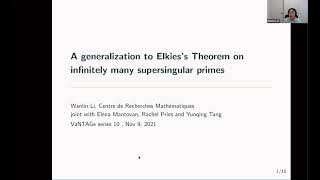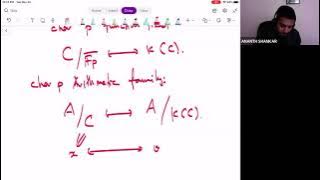
C18 Example problem using the superposition approach
Example problem solving with the superposition approach.
From playlist Differential Equations

Proves the Principle of Superposition for linear, homogeneous odes. Join me on Coursera: Matrix Algebra for Engineers: https://www.coursera.org/learn/matrix-algebra-engineers Differential Equations for Engineers: https://www.coursera.org/learn/differential-equations-engineers Vector C
From playlist Differential Equations

Differential Equation - 2nd Order (7 of 54) The Superposition Principle: Example
Visit http://ilectureonline.com for more math and science lectures! In this video I will give an example of the superposition principle with y”-y=0 with the solutions y1=e^x and y2=e^-x. Next video can be seen at: https://youtu.be/CNrQcfJGK2k
From playlist DIFFERENTIAL EQUATIONS 11 - 2nd ORDER, A COMPLETE OVERVIEW

Noam Elkies, Supersingular reductions of elliptic curves
VaNTAGe seminar, October 26, 2021 License: CC-BY-NC-SA
From playlist Complex multiplication and reduction of curves and abelian varieties

Wanlin Li, A generalization of Elkies' theorem on infinitely many supersingular primes
VaNTAGe seminar, November 9, 2021 License: CC-BY-NC-SA
From playlist Complex multiplication and reduction of curves and abelian varieties

Valentijn Karemaker, Mass formulae for supersingular abelian varieties
VaNTAGe seminar, Jan 18, 2022 License: CC-BY-NC-SA Links to some of the papers mentioned in this talk: Oort: https://link.springer.com/chapter/10.1007/978-3-0348-8303-0_13 Honda: https://doi.org/10.2969/jmsj/02010083 Tate: https://link.springer.com/article/10.1007/BF01404549 Tate: https
From playlist Curves and abelian varieties over finite fields

C07 Homogeneous linear differential equations with constant coefficients
An explanation of the method that will be used to solve for higher-order, linear, homogeneous ODE's with constant coefficients. Using the auxiliary equation and its roots.
From playlist Differential Equations

Steven Galbraith, Isogeny graphs, computational problems, and applications to cryptography
VaNTAGe Seminar, September 20, 2022 License: CC-BY-NC-SA Some of the papers mentioned in this talk: Ducas, Pierrot 2019: https://link.springer.com/article/10.1007/s10623-018- 0573-3 (https://rdcu.be/cVYrC) Kohel 1996: http://iml.univ-mrs.fr/~kohel/pub/thesis.pdf Fouquet, Morain 2002: ht
From playlist New developments in isogeny-based cryptography

Overview of Linear equations - Free Math Videos - Online Tutor
👉 Learn how to determine if an equation is a linear equation. A linear equation is an equation whose highest exponent on its variable(s) is 1. The variables do not have negative or fractional, or exponents other than one. Variables must not be in the denominator of any rational term and c
From playlist Write Linear Equations

Differential Equation - 2nd Order (6 of 54) The Superposition Principle
Visit http://ilectureonline.com for more math and science lectures! In this video I will explain what is the superposition principle. Next video can be seen at: https://youtu.be/mZOJFbtcmmc
From playlist DIFFERENTIAL EQUATIONS 11 - 2nd ORDER, A COMPLETE OVERVIEW

Benjamin Smith, Isogenies in genus 2 for cryptographic applications
VaNTAGe seminar, October 4, 2022 License: CC-BY-NC-SA
From playlist New developments in isogeny-based cryptography

Sarah Post: Rational extensions of superintegrable systems, exceptional polynomials & Painleve eq.s
Abstract: In this talk, I will discuss recent work with Ian Marquette and Lisa Ritter on superintegable extensions of a Smorodinsky Winternitz potential associated with exception orthogonal polynomials (EOPs). EOPs are families of orthogonal polynomials that generalize the classical ones b
From playlist Integrable Systems 9th Workshop

Chole Martindale, Torsion point attacks on the SIDH key exchange protocol
VaNTAGe Seminar, November 8, 2022 License: CC-BY-NC-SA Links to papers mentioned in the video: Jao-De Feo-Plut (2011): https://eprint.iacr.org/2011/506.pdf Galbraith-Petit-Shani-Ti (2016): https://eprint.iacr.org/2016/859 Petit (2017): https://eprint.iacr.org/2017/571 dQKLMPPS (2020): h
From playlist New developments in isogeny-based cryptography

Wouter Castryck, An efficient key recovery attack on supersingular isogeny Diffie-Hellman
VaNTAGe Seminar, October 18, 2022 License: CC-BY-NC-SA Links to some of the papers mentioned in this talk: Rostovstev-Stolbunov: https://eprint.iacr.org/2006/145 Charles-Goren-Lauter: https://eprint.iacr.org/2006/021 Jao-De Feo: https://eprint.iacr.org/2011/506 Castryck-Decru: https://e
From playlist New developments in isogeny-based cryptography

What does it mean to be a "Linear" Differential Equation?
This video explores what it means for a differential equation to be linear. Specifically we discuss the importance of linear superposition and give examples of linear and nonlinear operators and differential equations. Playlist: https://www.youtube.com/playlist?list=PLMrJAkhIeNNTYaOnVI3
From playlist Engineering Math: Differential Equations and Dynamical Systems

Kritin Lauter, Supersingular isogeny graphs in cryptography
VaNTAGe Seminar, September 20, 2022 License: CC-BY-NC-SA Some of the papers mentioned in this talk: Charles, Goren, Lauter 2007: https://doi.org/10.1007/s00145-007-9002-x Mackenzie 2008: https://doi.org/10.1126/science.319.5869.1481 Pizer 1990: https://doi.org/10.1090/S0273-0979-1990-15
From playlist New developments in isogeny-based cryptography

(2.3.1) Introduction to Higher Order Linear Differential Equations and Related Theorem
The video introduces higher order linear differential equations and related theorems on superposition, existence and uniqueness, and linear independence. https://mathispower4u.com
From playlist Differential Equations: Complete Set of Course Videos

Kirsten Eisenträger: Computing endomorphism rings of supersingular elliptic curves
CIRM HYBRID EVENT Computing endomorphism rings of supersingular elliptic curves is an important problem in computational number theory, and it is also closely connected to the security of some of the recently proposed isogeny-based cryptosystems. In this talk we give a new algorithm for co
From playlist Number Theory

Learn how to use the equality property of exponents to solve with negative exponents
👉 Learn how to solve exponential equations involving fractions. An exponential equation is an equation in which a variable occurs as an exponent. To solve an exponential equation, we make the base of both sides of the equation to be equal so that we can then equate the exponents. When the
From playlist Solve Exponential Equations with Fractions

Ananth Shankar, Picard ranks of K3 surfaces and the Hecke orbit conjecture
VaNTAGe Seminar, November 23, 2021
From playlist Complex multiplication and reduction of curves and abelian varieties